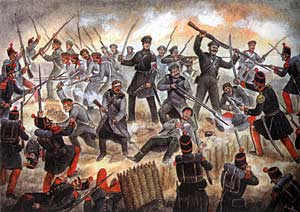|
|||
|
Philatelia.Net / Fragments of Russian History / Plots / The directory «Plots»The Siege of SevastopolThe Siege of Sevastopol (sometimes rendered "Sebastopol") was a major siege during the Crimean War, lasting from September 1854 until September 1855. Leo Tolstoy's early book The Sebastopol Sketches (1855–56) detailed the siege in a mixture of reportage and short fiction. In September 1854, Allied troops (United Kingdom, French and Piedmontese) landed in the Crimea and besieged the city of Sevastopol, home of the Tsar's Black Sea Fleet which threatened the Mediterranean. Before it could be encircled, the Russian field army withdrew. At the start of October, French and British engineers, moving from their base at Balaclava, began to direct the building of siege lines along the Chersonese uplands to the south of Sevastopol. The troops dug redoubts, gun batteries and trenches. With the Russian army and its commander Prince Menshikov gone, the defence of Sevastopol was led by Vice Admirals Vladimir Kornilov and Pavel Nakhimov, assisted by Menshikov's chief engineer, Lieutenant Colonel Eduard Todleben. The military forces available to defend the city were 4,500 militia, 2,700 gunners, 4,400 marines, 18,500 naval seamen and 5,000 workmen, totalling just over 35,000 men. The Russians first began scuttling their ships to protect the harbour, then used their naval cannon as additional artillery and the ships' crews as marines. Those ships deliberately sunk by the end of 1855 included Grand Duke Constantine, City of Paris (both with 120 guns), Brave, Empress Maria, Chesme, Yagondeid (84 guns), Kavarna (60 guns), Konlephy (54 guns), steam frigate Vladimir, steamboats Thunderer, Bessarabia, Danube, Odessa, Elbrose and Krein. By mid-October 1854, the Allies had some 120 guns ready to fire on Sevastopol; the Russians had about three times as many to return fire and defend against attacking infantry. On October 17, 1854, the artillery battle began. The Russian artillery first destroyed a French magazine, silencing their guns. British fire then set off the magazine in the Malakoff redoubt, killing Admiral Kornilov, silencing most of the Russian guns there and leaving a gap in the city's defences. However, the British and French withheld their planned infantry attack and a possible early end to the siege was missed. At the same time, the Allies' ships pounded the Russian defences, taking damage but inflicting little in return before their retirement. The bombardment resumed the following day; but, working overnight, the Russians had repaired the damage caused. This would become the pattern repeated throughout the siege. During October and November 1854, the battles of Balaclava and Inkerman took place beyond the siege lines. After Inkerman, the Russians saw that the Sevastapol siege would not be lifted by a battle in the field, so moved their troops piece by piece into the city to aid the defenders. Toward the end of November, the weather broke and winter brought a storm which ruined the Allies' camps and supply lines. Men and horses became sick and starved in the poor conditions. While Totleben extended the fortifications around the Redan, the Flagstaff Bastion and the Malakoff, the British chief engineer John Burgoyne sought to take the Malakoff, which he saw as the key to Sevastopol. Siege works were begun to bring the Allied troops nearer to the Malakoff; in response, Totleben dug rifle pits from where the Russians could snipe at the besiegers. In a foretaste of the trench warfare that became the hallmark of the First World War, these pits became the focus of Allied assaults. Once winter subsided, the Allies were able to restore many supply routes. A new railway, the "Grand Crimean Central Railway" built by the contractors Thomas Brassey and Samuel Peto, was used to bring supplies from Balaclava to the siegelines, delivering more than five hundred guns and plentiful ammunition. Starting on April 8, 1855 (Easter Sunday), the Allies resumed their bombardment of the Russian defences. On 30 June, Admiral Nakhimov died from a head wound inflicted by an Allied sniper. Within three months, Sevastopol finally fell. Although defended heroically and at the cost of heavy Allied casualties, the fall of Sevastopol would lead to the Russian defeat in the Crimean War. The most of Russian defenders of the city were buried in Brotherhood cemetery in over 400 collective graves. Great Britain, 2006, Charles Lucas Madagaskar, 1988, Ship on the line «Twelve Apostols» Russia, 2008, Flags, Monument «To the flooded ships» Ukraine, 1998, Monument «To the flooded ships» Ukraine, 2001, Ship on the line «Twelve Apostols» Ukraine, 2002, Fregate «Sizopol» Ukraine, 2003, Paddle streamer «Grozny» Ukraine, 2003, Paddle streamer «Odessa» Ukraine, 2005, Monument «To the flooded ships» Ukraine, 2010, Defense of Sevastopol USSR, 1954, Monument «To the flooded ships», words of Tolstoy USSR, 1965, Monuments of Sevastopol USSR, 1983, Monument «To the flooded ships» Great Britain, 2004.10.12, Ukraine, Ukraine, 2004.09.25, Ukraine, 2005.06.11, Ukraine, 2005.06.14, Ukraine, 2008.06.14, USSR, 1964.05.09, USSR, 1967.11.07, USSR, 1969.05.09, USSR, 1983.06.14, USSR, 1983.06.19—11, Russia, 1999, Russia, 2004, Ukraine, 1991, Ukraine, 1993, Ukraine, 2004, Ukraine, 2007, Ukraine, 2008, USSR, 1956, USSR, 1959, USSR, 1959, USSR, 1960, USSR, 1963, USSR, 1964, USSR, 1967, USSR, 1969, USSR, 1973, USSR, 1976, USSR, 1977, USSR, 1980, USSR, 1980, USSR, 1982, USSR, 1982, USSR, 1983, USSR, 1983, USSR, 1984, USSR, 1985, USSR, 1985, USSR, 1987, USSR, 1988, USSR, 1989, USSR, 1990, USSR, 1990, USSR, 1961, USSR, 1965.06.18, USSR, 1968.03.25, USSR, 1969.07.09, USSR, 1970.11.02, USSR, 1974.12.17, USSR, 1976.11.29, USSR, 1977.03.16, USSR, 1978.03.17, USSR, 1979.03.13, USSR, 1979.04.12, USSR, 1979.12.28, USSR, 1981.11.18, USSR, 1984.05.21, USSR, 1985.02.01, USSR, 1985.02.01, USSR, 1987.12.22, USSR, 1988.01.18, Advertising: |
|||
© 2003-2025 Dmitry Karasyuk. Idea, preparation, drawing up
|

